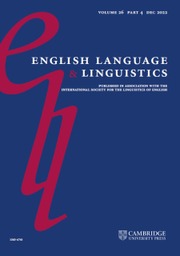No CrossRef data available.
Article contents
Thomas Herbst and Thomas Hoffmann, A Construction Grammar of the English language: CASA – a constructionist approach to syntactic analysis (Cognitive Linguistics in Practice 5). Amsterdam and Philadelphia: John Benjamins, 2024. Pp. xvi + 315. ISBN 9789027214980.
Review products
Thomas Herbst and Thomas Hoffmann, A Construction Grammar of the English language: CASA – a constructionist approach to syntactic analysis (Cognitive Linguistics in Practice 5). Amsterdam and Philadelphia: John Benjamins, 2024. Pp. xvi + 315. ISBN 9789027214980.
Published online by Cambridge University Press: 26 September 2025
Abstract
An abstract is not available for this content so a preview has been provided. Please use the Get access link above for information on how to access this content.

Information
- Type
- Book Review
- Information
- Copyright
- © The Author(s), 2025. Published by Cambridge University Press
References
Dąbrowska, Ewa. 2009. Words as constructions. In Evans, Vyvyan & Pourcel, Stéphanie (eds.), New directions in Cognitive Linguistics, 201–23. Amsterdam and Philadelphia: John Benjamins.10.1075/hcp.24.16dabCrossRefGoogle Scholar
Herbst, Thomas. 2024. High and low level constructions in dictionaries and constructiCons: The interplay between lexical and syntactic information in CASA|Con. Lexicographica 40(1), 149–85. https://doi.org/10.1515/lex-2024-0008CrossRefGoogle Scholar
Herbst, Thomas & Hoffmann, Thomas. 2018. Construction Grammar for students: A constructionist approach to syntactic analysis (CASA). Yearbook of the German Cognitive Linguistics Association 6(1), 197–218. https://doi.org/10.1515/gcla-2018-0010CrossRefGoogle Scholar
Hilpert, Martin. 2019. Construction Grammar and its application to English, 2nd edn. Edinburgh: Edinburgh University Press.10.1515/9781474433624CrossRefGoogle Scholar
Hoffmann, Thomas. 2022. Construction Grammar: The structure of English. Cambridge: Cambridge University Press.10.1017/9781139004213CrossRefGoogle Scholar
Lyngfelt, Benjamin, Borin, Lars, Ohara, Kyoko & Torrent, Tiago Timponi (eds.). 2018. Constructicography: Constructicon development across languages. Amsterdam and Philadelphia: John Benjamins.10.1075/cal.22CrossRefGoogle Scholar
MacWhinney, Brian. 2000. The CHILDES project: Tools for analyzing talk. Mahwah, NJ: Lawrence Erlbaum Associates.Google Scholar
Sinclair, John. 1991. Corpus, concordance, collocation. Oxford: Oxford University Press.Google Scholar
Ungerer, Tobias & Hartmann, Stefan. 2023. Constructionist approaches: Past, present, future. Cambridge: Cambridge University Press.10.1017/9781009308717CrossRefGoogle Scholar


